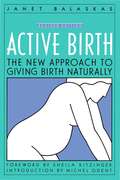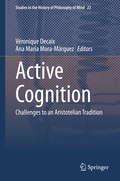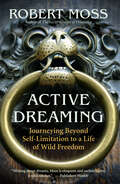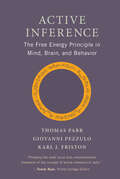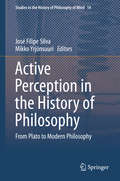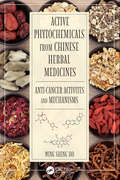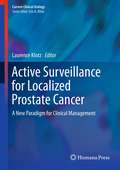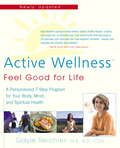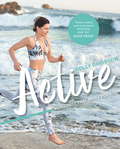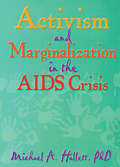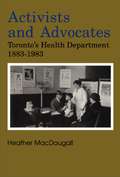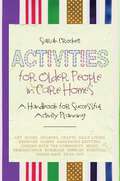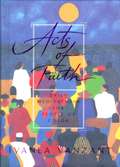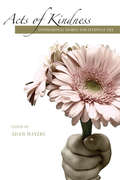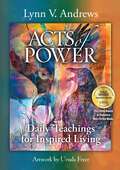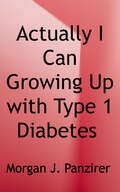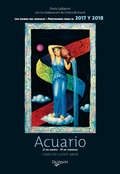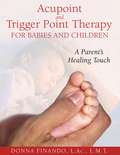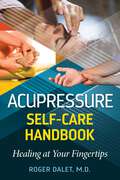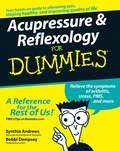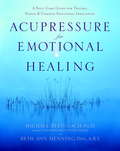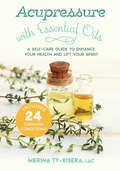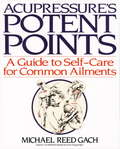- Table View
- List View
Active Birth - Revised Edition
by Janet BalaskasAn inspirational and instructive guide to those who want to give birth through their own efforts and to take full control of the birth.
Active Cognition: Challenges to an Aristotelian Tradition (Studies in the History of Philosophy of Mind #23)
by Véronique Decaix Ana María Mora-MárquezThis edited work draws on a range of contributed expertise to trace the fortune of an Aristotelian thesis over different periods in the history of philosophy. It presents eight cases of direct or indirect challenges to the Aristotelian passive account of human cognition, taking the reader from late antiquity to the 20th century. Chapters analyse the (often indirect) effect of Aristotle’s account of cognition on later periods. In his influential De anima, Aristotle describes human cognition, both sensitive and intellectual, as the reception of a form in the cognitive subject. Aristotle’s account has been commonly interpreted as fundamentally passive – the cognitive subject is a passive actor upon which a cognitive process is acted by the object. However, at least from the time of Alexander of Aphrodisias onwards, this interpretation has been challenged by authors who posit a fundamental active aspect of cognition. Readers will discover how one or more of three concerns – ontological superiority, direct realism and moral responsibility – drive the active accounts of cognition. Contributed chapters from top scholars examine how these three concerns lead thinkers to take issue with the idea that cognition is a passive process. The authors consider Jesuit accounts of cognition, Malebranche on judgment, and Wittgenstein on perception, as well as Stumpf on active cognition, among other relevant works. This book is ideally suited to scholars of philosophy, especially those with an interest in medieval epistemology, the influence of Aristotle, philosophy of mind and theories of cognition.
Active Dreaming: Journeying Beyond Self-Limitation to a Life of Wild Freedom
by Robert MossAs the success of the recent film Inception shows, dreams are a source of perennial fascination. Robert Moss has advanced our understanding of the phenomenon with his visionary and down-to-earth synthesis of contemporary dreamwork and venerable shamanic methods. His “active dreaming” involves re-entering dreams, exploring their possibilities, and directing the subconscious to illuminate and solve problems. He blazes a new trail, guiding readers to use the powers that govern their night dreams to pursue their ideal waking “dream lives.” Based on Moss's decades of teaching, the techniques he shares in these pages are proven, powerful, and even playful. Readers learn to understand and utilize synchronicity, shared dreaming, children's dreams, and healing dreams. The examples Moss shares encourage readers to face fears and tap into dormant power. The result is the freedom to choose — and then revel in — the life of their dreams.
Active Inference: The Free Energy Principle in Mind, Brain, and Behavior
by Thomas Parr Karl J. Friston Giovanni PezzuloThe first comprehensive treatment of active inference, an integrative perspective on brain, cognition, and behavior used across multiple disciplines. Active inference is a way of understanding sentient behavior—a theory that characterizes perception, planning, and action in terms of probabilistic inference. Developed by theoretical neuroscientist Karl Friston over years of groundbreaking research, active inference provides an integrated perspective on brain, cognition, and behavior that is increasingly used across multiple disciplines including neuroscience, psychology, and philosophy. Active inference puts the action into perception. This book offers the first comprehensive treatment of active inference, covering theory, applications, and cognitive domains. Active inference is a &“first principles&” approach to understanding behavior and the brain, framed in terms of a single imperative to minimize free energy. The book emphasizes the implications of the free energy principle for understanding how the brain works. It first introduces active inference both conceptually and formally, contextualizing it within current theories of cognition. It then provides specific examples of computational models that use active inference to explain such cognitive phenomena as perception, attention, memory, and planning.
Active Perception in the History of Philosophy: From Plato to Modern Philosophy (Studies in the History of Philosophy of Mind #14)
by José Filipe Silva Mikko YrjönsuuriThe aim of the present work is to show the roots of the conception of perception as an active process, tracing the history of its development from Plato to modern philosophy. The contributors inquire into what activity is taken to mean in different theories, challenging traditional historical accounts of perception that stress the passivity of percipients in coming to know the external world. Special attention is paid to the psychological and physiological mechanisms of perception, rational and non-rational perception and the role of awareness in the perceptual process. Perception has often been conceived as a process in which the passive aspects - such as the reception of sensory stimuli - were stressed and the active ones overlooked. However, during recent decades research in cognitive science and philosophy of mind has emphasized the activity of the subject in the process of sense perception, often associating this activity to the notions of attention and intentionality. Although it is recognized that there are ancient roots to the view that perception is fundamentally active, the history remains largely unexplored. The book is directed to all those interested in contemporary debates in the fields of philosophy of mind and cognitive psychology who would like to become acquainted with the historical background of active perception, but for historical reliability the aim is to make no compromises.
Active Phytochemicals from Chinese Herbal Medicines: Anti-Cancer Activities and Mechanisms
by Wing Shing HoBiomedical ScienceChinese herbal medicine represents complementary or adjunctive therapies that often can improve the efficacy of Western medicine to achieve the pharmacological effects, especially in cancer treatment. However, the combination of herbs with therapeutic drugs can raise potential health risk. Building a bridge between Western medicin
Active Surveillance for Localized Prostate Cancer: A New Paradigm for Clinical Management (Current Clinical Urology)
by Laurence KlotzActive Surveillance for Localized Prostate Cancer: A New Paradigm for Clinical Management will serve as a useful resource for physicians dealing with, and interested in, this complex and evolving branch of prostate cancer management. The book will also be of interest to scientifically literate patients and their families. The volume provides an introduction to the concept of active surveillance in oncology in general and prostate cancer specifically. The primary focus is to provide a comprehensive guide to the management of patients on surveillance. The volume covers the many complexities and nuances to this approach including, patient selection, risk assessment, how to overcome 'cancer hysteria' when counseling patients, identifying appropriate triggers for intervention, use of PSA kinetics and MR imaging information, technique and frequency of biopsies, secondary prevention interventions, and the relative roles of surveillance and focal therapy.
Active Wellness (rev. edition): Feel Good for Life
by Gayle ReichlerEnlightened by the author's own story of recovery from cancer, here is a unique lifestyle philosophy and a practical guide to feeling your best for a lifetime. Active Wellness encompasses every facet of choosing- and, more important, staying with-a healthy lifestyle. From mental preparation to changing old habits; from creating personal eating and fitness plans to recognizing and managing stress; from dealing with the threat of self-sabotage to celebrating the thrill of success, this is a unique, full-spectrum program that has been proven effective, showing that healthy living is easy when it is satisfying to your body, mind, and spirit. A comprehensive health plan with a strong weight-management component, the Active Wellness program has been adopted by tens of thousands of individuals, groups, and corporations across the country
Active: Workouts that work for you
by Holly Davidson'Holly makes exercise seem effortless and fun.' - Sadie FrostWe all want to feel fit, healthy and strong, but with today's fast-paced lifestyles it can be hard to find the time or motivation to work out. Holly Davidson is a top personal trainer who has used her years of experience to devise an exercise programme that is varied, flexible, fun and easy to fit into your day to day life.Holly is used to working with clients who have jam-packed schedules, so she has dozens of clever tips that will help fit your workout into your regular routine. This book will guide you to maximise the experience of training anywhere, and to use these tools and techniques to craft a regime that is not boring, repetitive, monotonous, but instead varied and diverse.Holly's sustainable, holistic approach is based on balance and setting realistic and achievable goals. It's not about crash dieting or scrambling to get a bikini body - it's about integrating fitness into your lifestyle and making workouts work for you.With her encouraging tone and easy-to-follow exercise routines, Holly is with you every step of the way. Feel happy. Feel healthy. Feel strong. And get active!
Activism and Marginalization in the AIDS Crisis
by Michael A HallettActivism and Marginalization in the AIDS Crisis shows readers how the advent of HIV-disease has brought into question the utility of certain forms of “activism” as they relate to understanding and fighting the social impacts of disease. This informative and powerful book is centrally concerned about the ways in which institutionally governed social constructions of HIV/AIDS affect policy and public images of the disease more so than activist efforts. It asserts that an accounting of the power institutional structures have over the dominant social constructions of HIV disease is fundamental to adequate forms of present and future AIDS activism. Chapters in Activism and Marginalization in the AIDS Crisis demonstrate how, despite what is thought of as the “successful activism” of the past decade, the claims of the HIV-positive are still being ignored, still being marginalized, and still being administratively “handled” and exploited even as the plight of those who find themselves HIV-positive worsens. Although chapters reject the assertion that activism has been a highly effective remedy to HIV-positive voicelessness, authors do not deny that activists have been vocal, but that they continue to be ignored despite their vocality.Contributors in Activism and Marginalization in the AIDS Crisis offer numerous examples of institutional control and demonstrate that institutional structures, and not activists, are controlling the public meaning of HIV-related issues. Readers learn how messages about HIV/AIDS are produced, negotiated, modified, and sustained through institutional mechanisms that serve mostly institutional interests rather than those of the HIV-positive. In gaining an understanding of these issues, readers will begin to learn how to modify and strengthen activist efforts with valuable insight on: the lack of HIV-positive voices in mainstream news portrayals of HIV/AIDS research on constructions of HIV-disease at the state government level social constructions and how they affect HIV/AIDS policy the political construction of AIDS and interest-based struggles the emergent “bio-politics” of HIV and homosexuality in the U.S. how institutional power works to govern public understanding of HIV diseaseInstitutional structures are defined in this book as groups engaged in and defined by the production of various “truths” which sustain them. Institutional power may be defined as the capacity to regulate, constrain, and disseminate versions of “truth.” Activism and Marginalization in the AIDS Crisis reveals how HIV activist groups have been outmaneuvered when it comes to the production and dissemination of various “truths” about HIV/AIDS by institutional structures more deeply steeped in social legitimacy and which have a superior capacity for message dissemination.HIV/AIDS activists, HIV-positive persons and those with AIDS, HIV/AIDS educators, public and institutional policymakers, health professionals, and the general public will find this book essential to understanding the social constructions of HIV/AIDS, how these affect HIV/AIDS-related policy and public opinion, and how to begin to cipher through the plethora of information to find and promote the “truth.”
Activists and Advocates: Toronto's Health Department 1883-1983
by Heather MacdougallFor more than a century, Toronto’s Health Department has served as a model of evolving municipal public health services in Canada and beyond. From horse manure to hippies and small pox to AIDS, the Department’s staff have established and maintained standards of environmental cleanliness and communicable disease control procedures that have made the city a healthy place to live. This centennial history anlyzes the complex interaction of politics, patronage and professional aspirations which determine the success or failure of specific policies and programs. As such, it fills a long neglected gap in our understanding of the development of local health services. Using Toronto’s changing circumstances as a backdrop, the book details the evolution of the international public health movement through its various phases culminating in the modern emphasis on health promotion and health advocacy. By so doing, it demonstrates the significant contribution of preventive medicine and public health activities to Canadian life
Activities for Older People in Care Homes: A Handbook for Successful Activity Planning
by Sarah CrockettWhen tasked with providing activities for older people in care homes, it can be difficult to know where to begin. What constitutes an activity? How can you make sure activities are as positive and person-centred as possible? What can you actually do? Written by an experienced activity coordinator, this handbook is an indispensable companion for others in this role. The author provides useful background information on dementia, the importance of activities and how to get to know residents through life story work. She addresses important practical considerations such as how to assess a resident for suitable activities, activity planning, timetabling, budgeting and money-stretching, as well as more subtle issues such as how to enthuse residents and staff to join in and how to deal with resistance from colleagues. An A-Z of inventive ideas and step-by-step instructions for activities as wide-ranging as arts and crafts, cooking, exercise, gardening, meditation, music, reminiscence, themed days and trips out is also included. Offering peer-to-peer advice and encouragement as well as a wealth of practical ideas and suggestions, this is essential reading for all those involved in activity planning for older people, including those with dementia, in care homes.
Acts of Consciousness
by Guy SaundersDrawing on compelling material from research interviews with former hostages and political prisoners, Guy Saunders reworks three classic thought experiment stories: Parfit's 'Teleporter', Nagel's 'What is it like to be a bat?' and Jackson's 'Mary the colour scientist' to form a fresh look at the study of consciousness. By examining consciousness from a social psychology perspective, Saunders develops a 'cubist psychology of consciousness' through which he challenges the accepted wisdom of mainstream approaches by arguing that people can act freely. What makes 'cubist psychology' is both the many examples taken from different viewpoints and the multiple ways of looking at the key issues of person, mind and world. This is a unique and engaging book that will appeal to students and academics in the field of consciousness studies and other readers with an interest in consciousness.
Acts of Faith: Daily Meditations for People of Color
by Iyanla VanzantBeloved Friends,Acts of Faith,more affectionately known as "the purple book," has truly taken on a life of its own. It has crossed gender lines to foster understanding, racial divides to create peace, religious barriers to encourage tolerance, and has become somewhat of a lantern for those seeking a better way of life. I have been told it has saved lives, renewed faith, created vision and healed wounds. Some day it has comforted them. Others say it has enlightened them. It has changed perspectives for some, directions for others and lives for many. I can take no credit for any of this. In fact, I give the credit to those of you who were willingly seeking, open and easy for whatever blessing you received from your interaction with this book. My goal in writing the book was to provide a service. At that time I never imagined how greatly I would be served. The kindness, generosity and love I have received in a response to this book has been, at times, overwhelming. Because we live in a world and during a time when we are untrusting, almost afraid of one another; we can forget how loving and supportive people can be. We also live in an environment where we tend to think of one another as them and us; the haves and the have nots. My experience during both the writing and promotion ofActs of Faithhas served as a valuable reminder of how alike we all are. We all cry. We all hurt. We all want to do better. We all learn and we all grow. I have grown tremendously since the publication ofActs of Faith. In both my personal and professional life, I have grown in the realization of just how precious life is and how blessed we are to be alive. I have grown to appreciate the delicate balance between surviving and flourishing. I have grown in the realization of the awesome responsibility one undertakes when they seek to serve. More important, I have grown stronger in my faith and belief that God is happy when His children are happy. You and I are God's precious children. Acts of Faithhas brought an incredible amount of happiness into my life. For this, I am grateful. I am happy that so many are searching for the truth about life and about themselves. I am happy that people from all walks of life, all social backgrounds are developing a deeper sense of awareness and connection to the beauty of life and the glory of God. I am grateful that from a very rocky beginning in life, I have been entrusted by the Creator to bring forth a message of truth and healing. I am grateful that healing is available and that many have found the healing that they sought in the pages of this little purple book. People often ask me, "What are your plans for the future? What will you do next?" They are somewhat taken aback by my casual response, "I haven't got a clue!"Acts of Faithhas taught me the value of surrender and the wisdom of not getting bogged down in all the details of life. I know that God has a plan for me and for us. I know that when you have pure intent and a loving desire, God will not forsake you. I wanted to show my appreciation to you by offering this gift edition ofActs of Faithas a special way of letting you know how much your love and support has meant to me. Give it to a friend or a loved one, or present it to yourself as a reminder that when you act on faith, you rarely go wrong and you are always blessed. Thank you for blessing me with your love. Iyanla
Acts of Kindness: Inspirational Stories for Everyday Life
by Adam MayersSmall things can often mean a great deal. For the past five years readers of the Toronto Star's website have been telling each other that, as they shared their stories in a feature called "Acts of Kindness." The common thread is that a stranger helped when it was needed most, without thought of a reward and often without leaving a name. Since its debut in December, 2004, "Acts of Kindness" has become a daily fixture at thestar.com. About four thousand stories have been submitted and two thousand have been published. Acts of Kindness, the book, represents the best of the best - a collection of 200 of the most memorable tales. The stories are a reminder that goodness is non-denominational, non-political, and transferable across race and language. They also remind us that although our lives are full of hard realities, the smallest gesture can raise a spirit or lift a heart, and the time to do it is now.
Acts of Power: Daily Teachings for Inspired Living
by Lynn V. AndrewsActs of Power, compiled from Lynn Andrews&’s extensive publication history, is a brilliant daily companion offering 365 days of wisdom and inspiration. These short daily teachings will assist you in being present with your desires, nurture your spiritual growth, and encourage you to remain grounded every day of the year.Lynn Andrews&’s new book Acts of Power is an intensely personal document that has assumed a special individual significance for contemporary readers, providing them with 365 daily inspirations that offer pivotal insights for living a joyful life. Andrews has distilled twenty-one books into this daily companion edition to support and inspire you in a small, easy-to-follow, yet very important and powerful tool for living well. Transcending the borders of age and background, Acts of Power&’s spectrum of experience, thought, and wisdom invites direct identification and a sense of recognition, a sharing of concerns and solutions.
Actually, I Can: Growing Up with Type 1 Diabetes, a Story of Unexpected Empowerment
by Morgan J. PanzirerMorgan was diagnosed with Type 1 Diabetes at 6 years old -- but that didn't stop her! In this informative memoir, she looks back at her life and shares her experiences to help others who've been diagnosed, and their families, to understand everything from the gadgets to the legislation, the joy and the frustrations. Morgan has dedicated her life to the advocacy and education of her disease.
Acuario
by Chiara Bertrand Doris Saltarini¿Quiere saber qué le deparan el 2017 y el 2018? Este libro contiene las previsiones llevadas a cabo por Doris Saltarini y Chiara Bertrand, a través de las cuales podrá descubrir las grandes líneas de su destino en todos los terrenos (vida sentimental, profesión, dinero, salud...). Además, se incluye un capítulo en el que podrá conocer el nombre de personajes famosos con su mismo signo del zodiaco. Esta obra, indispensable para todos los aficionados a la astrología, le explicará las características generales de Acuario, la influencia de los planetas en su personalidad, el papel de las casas y del ascendente. Encontrará, asimismo, valiosas indicaciones sobre el modo de construir una ficha astrológica personal, las profesiones que más le convienen y sus relaciones con los demás signos.
Acupoint and Trigger Point Therapy for Babies and Children: A Parent's Healing Touch
by Donna FinandoTechniques that allow parents to be active agents in providing relief and healing when illness occurs in their children • Reveals the importance of touch in both childhood development and healing • Details acupoint and trigger point therapy techniques for most common childhood ailments, including asthma • Identifies when to seek professional help vs. situations that can be handled at home Touch is critical to the development of babies and children. It establishes both their sense of self and their connectedness to the rest of the world. Donna Finando shows that touch is also key to restoring health when illness occurs. As a mother and grandmother, she has experienced the frustration and helplessness of watching a sick child suffer. As an acupuncturist and massage practitioner, she has found there are many simple ways parents can provide relief and even healing for many common ailments that afflict children by using touch therapy.Trigger point therapy releases restricted muscles while acupressure allows energy to flow freely, activating the body’s remarkable healing abilities. Colds, sore throats, ear infections, constipation, diarrhea, vomiting, and even asthma are some of the common conditions that can be relieved by touch therapy. Finando presents an in-depth explanation of each condition, providing information on causative factors, dietary and behavior recommendations, point techniques that can offer relief, and when to seek medical help. The gentle techniques that form this healing practice also extend to other parent-child interactions, offering a comprehensive model for the care and nurturing of children.
Acupressure Self-Care Handbook: Healing at Your Fingertips
by Roger DaletA guide to acupressure treatments for more than 150 common illnesses and conditions• Shares step-by-step treatment protocols for illnesses such as cold, flu, or digestive problems; chronic conditions such as arthritis, diabetes, and thyroid disorders; and nervous system and emotional complaints such as depression, shingles, Bell&’s palsy, and stage fright • Includes detailed diagrams of the commonly known and prescribed acupressure points as well as important new acupoints discovered by contemporary Chinese medical researchers • Explains how acupressure stimulates the body&’s natural healing ability With the simple touch of your fingertips you can quickly and easily bring comfort and relief from pain and illness. In this illustrated guide to acupressure for self-care and care of your loved ones, Roger Dalet, M.D., shares step-by-step treatment protocols for more than 150 diseases and disorders—from illnesses such as cold, flu, or digestive upset to chronic conditions such as arthritis, diabetes, thyroid disorders, and heart problems to nervous system and emotional complaints such as depression, shingles, and Bell&’s palsy. Exploring how acupressure works, the author explains how massaging specific healing points stimulates the body&’s own natural healing ability. Within each treatment protocol, he offers guidance on how acupressure can best help the situation—whether it is capable of completely curing a condition or whether it should be used to support other healing modalities. In addition to detailed diagrams of the commonly known and prescribed acupressure points, Dr. Dalet includes important new acupoints discovered by contemporary Chinese medical researchers that address ailments resulting from our more sedentary lifestyles and use of computers, such as obesity and eye strain. He also recommends the most effective options for stimulating the points, including devices for electrical stimulation. A valuable resource for any home, the acupressure treatments presented in this handbook can provide immediate relief for pain and injuries as well as be used preventively. Most important, they offer an effective method of self-care and a way to provide comfort and relief to ailing loved ones, especially the delicate immune systems of children.
Acupressure and Reflexology For Dummies
by Bobbi Dempsey Synthia AndrewsFeatures healing routines and illustrations to guide youEase your aches and find relief through the power of touchSearching for alternative treatments for pain? This friendly, do-it-yourself guide introduces you to the basics and benefits of acupressure and reflexology, showing you step by step how to nurture your emotional and physical well-being and that of someone else. You'll see how to target specific body parts to address your ailments and improve your emotional as well as your physical well-being.Understand basic healing principlesRelieve your specific aches and painsBoost your immune systemAddress age-related ailmentsFind professional help
Acupressure for Emotional Healing: A Self-Care Guide for Trauma, Stress & Common Emotional Imbalances
by Michael Reed Gach Beth Ann HenningIncreased stress and traumatic events in our lives have resulted in many millions of people who suffer from insomnia, nightmares, anxiety attacks, depression, and tension headaches. ACUPRESSURE FOR EMOTIONAL HEALING offers relief at your fingertips, quickly and safely, for a wide range of emotional problems. It explains how emotional distress becomes lodged in the body as muscular tension and blocked energy, and shows how acupressure can relieve not just the resulting physical symptoms, but also their emotional source--often without the need for extensive talk therapy or medication. Acupressure stimulates the same points used in acupuncture, but instead of needles, firm finger pressure is used on the surface of the skin. The pressure releases neurochemicals called endorphins that relieve pain. As in acupuncture, specific pressure points are connected with internal organs and energy pathways in the body (called meridians) that regulate the flow of electrical energy to all systems. Unlike acupuncture, acupressure can be used safely by anyone, with only the hands as equipment. ACUPRESSURE FOR EMOTIONAL HEALING offers a comprehensive A-Z guide to emotional ailments (from abandonment to worry and obsessive thinking), with fully-illustrated instruction on dozens of precise acupressure point locations and how to activate them, combined with yogic breathing, stretching, and movement routines. Case histories from the authors' practice further illuminate each condition and the path to emotional balance and healing. Most routines can be used independently for self-care and on-the-spot relief. There are also sections on how to use the techniques to help others, with appropriate safeguards.
Acupressure with Essential Oils: A Self-Care Guide to Enhance Your Health and Lift Your Spirit--Includes 24 Common Conditions
by Merina Ty-KiseraDiscover the healing power of essential oils paired with ancient acupressure techniques in this engaging guide to whole-body care Merina Ty-Kisera, an experienced healer and Five Element acupuncturist, introduces readers to her Aroma Acupressure method for selfcare—applying the healing properties of essential oils to pressure points that cue energetic changes to balance the body and mind. This guide empowers readers to reclaim their health with tips, routines, and strategies that support everything from relieving chronic tension, to coping with digestive ailments to treating cold and flu symptoms. Readers will rediscover an integrated sense of health and well-being.
Acupressure's Potent Points: A Guide to Self-Care for Common Ailments
by Michael Reed GachWith your hands you have potential to relieve everyday aches, pains and ailments without taking drugs, to improve your health, and to increase your vitality. Acupressure is an ancient healing art that uses the fingers to stimulate key points on the skin that, in turn, activate the body's natural self-healing processes. With this book, it is a skill you can learn now--and use in your own home. In Acupressure's Potent Points, Michael Reed Gach, founder and director of the Acupressure Institute of America, reveals simple techniques that enable you to relieve headaches, arthritis, colds and flu, insomnia, backaches, hiccups, leg pain, hot flashes, depression, and more--using the power and sensitivity of your own hands.This practical guide covers more than forty ailments and symptoms, from allergies to wrist pain, providing pressure-point maps and exercises to relieve pain and restore function. Acupressure complements conventional medical care, and enables you to take a vital role in becoming well and staying well. With this book you can turn your hands into healing tools--and start feeling good now.
Acupuncture Sema Easy
by M. MuthukumarThis book explains the basic features of Acupuncture Therapy and curing of certain ailments by applying Acupuncture Therapy.
